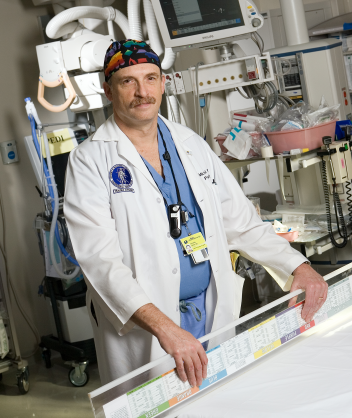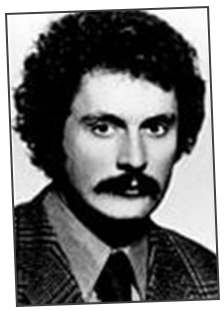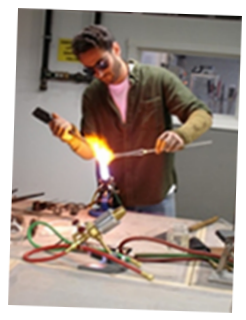Goods for Guns: A successful safety program born out of tragedy

A pediatric trauma surgeon for more than 25 years, Michael Hirsh, MD, professor of surgery and pediatrics, is known in Worcester as an active public health and child safety advocate, and as the man who brought the Goods for Guns buyback to the city. Since its inception in 2002, Goods for Guns, or G4G, has taken nearly 2,000 firearms off the streets and out of homes where they can pose a danger to children. Although many would see G4G as a simple but effective annual safety program, Hirsh sees it as a remarkable tribute to a friend and colleague who was slain for no reason by a kid with a handgun.
Working as a pediatric surgeon for the past 25 years, there is much that I have seen and experienced in a hospital setting that has been memorable. But the events of 29 years ago, involving the murder of one of my friends and fellow resident at Columbia-Presbyterian Hospital in the Washington Heights section of New York, is the event that I look back on as formative, seminal, critical.
John Chase Wood, II, MD, was a Julliard-trained French horn player, a graduate of both Columbia College and Columbia Medical School, and a board-eligible pediatrician who had decided to do a second residency to pursue his ultimate dream of becoming a pediatric surgeon. We shared that dream and even thought about going into practice together. The dream was snuffed out the night of Nov. 2, 1981, when John ventured out of our emergency department for what he thought would be just a moment to bring home crackers to his wife, Diana, who was in her first trimester of pregnancy and very nauseous. John never made it back to the ED as a doctor, but rather was wheeled in later that night as a patient with a lethal gunshot wound through the heart. He had been shot by a 15-year-old boy wielding a Saturday-night-special, who was angry when John, when asked what he had to give to his mugger, said, “I only have crackers.”

The staff of Columbia Medical Center was completely torn apart by this event. Twenty-three busloads of mourners went to John’s funeral in Princeton, N.J.—buses from Julliard, from the Columbia undergraduate campus and from the medical facility. The entire time we rode that sad route we imagined the revenge we could somehow exact from the neighborhood for failing to identify the perpetrator (in fact, the murderer was not found until 2001, when he confessed to the murder while serving time for another crime) and for standing quietly by the violence of the crack cocaine epidemic in “The Heights."
As the president of the Columbia Housestaff Association, I, too, was swept up in these revenge fantasies. But my very wise chairman of the Department of Surgery, Keith Reemtsma, MD—who was widely believed to have been the model for the character Hawkeye Pierce in Ring Lardner’s M*A*S*H*—called me into his office after the funeral and told me it was my job to keep a lid on the anger. Keith invited Jim and Sarah Brady of the Center for Handgun Violence to address the house staff; they convinced us that the gun was the vector of violence and that we had a chance to eradicate it. Much like the venerable Walter Reed was able to wipe out yellow fever in the Panama Canal Zone by attacking the mosquito, peacemakers could help stem the tide of violence by reducing the accessibility of the handgun. The message stuck, and thus began my career-long work to prevent injuries of all kinds, but particularly firearm injuries.
I worked on some of these issues when I set up the first injury prevention program in 1988 at what was then the University of Massachusetts Medical Center (now UMass Memorial Medical Center), work that I carried out with the help of a fellow New Yorker Matthew Masiello, MD, director of the pediatric ICU here. Our work was recognized in 1990 by then-Governor Michael Dukakis.
Career opportunities led us both to the North Side of Pittsburgh amidst another crack cocaine/gang war in which gunshot injuries were not uncommon. Seeing teens wheeled night after night into Allegheny General Hospital, we knew that something needed to be done. Around the same time, back in Washington Heights, a carpet store owner named Fernando Mateo surprised both himself and the country when his son’s idea to have people bring in guns in exchange for carpeting yielded about 2,000 weapons. The program, the original Goods for Guns concept, practically wiped out Mateo’s carpet inventory.
Matt went to NYC to visit with Mateo, and brought back the seeds of establishing the Allegheny County’s Goods for Guns program in 1994. Working in collaboration with the Pittsburgh Police Department’s Gun Task Force and some Pittsburgh department stores downtown, we offered gift certificates in exchange for weapons at Christmastime and were amazed to retrieve 1,400 weapons. We ran out of gift certificates and took turns running across the street to an ATM to get more money to buy gift cards at the local department stores. The program thrived, and since that first year has collected more than 11,000 weapons. Allegheny County, with a population of 1.4 million people, now has one of the lowest firearm injury rates of any comparable city.

As part of the Allegheny program, we collaborated with a number of metal-working artists, led by Boris Bally, who crafted an art show from the disassembled guns. Called “Artists of a Different Caliber,” the show toured the country in 1997; one piece was purchased by the Smithsonian American Art Museum. When Boris moved to Providence, he took a consignment of nearly 2,000 of the weapons to erect a 14-foot-tall, steel and cement obelisk that has almost 1,000 of these handguns embedded in its weathering surface. Though the sculpture was intended as a visiting art exhibit, its sheer size and weight made transportation difficult, and so it now stands in front of the state house in Providence with a sign acknowledging the Goods for Guns Program of Allegheny County.
When I moved back to Worcester in 2001, I worked with my new injury prevention partner, Mariann Manno, MD, director of the Pediatric Emergency Department at the UMass Memorial Children’s Medical Center, to establish a Worcester version of Goods for Guns. A collaborative was formed between UMass Medical School and UMass Memorial Medical Center with the Worcester Police Department, the Worcester DA’s office, the Worcester Department of Public Health, the Worcester District Medical Society and a corporate sponsor, Wal-Mart. In its first eight years, the program collected 1,861 weapons in exchange for gift cards. At an average cost of $53 per weapon, the program has cost $100,000, which is approximately the cost of caring for just two gunshot wound patients. Translated another way, if even two weapons of the 1,861 had caused an injury, the city and hospital system saved money. The cost of one year’s buyback (retrieving on average 220 weapons per year) equals the cost of about one day of care for the average gunshot victim. Of the weapons collected, about 60 percent were handguns, and about 40 percent were classified as semi-automatic—including at least 15 AK-47s. In addition to collecting weapons, we have given out more than 200 trigger locks each year, with the help of the Worcester Police Department and the Massachusetts Nurses Association.
While comparable cities like Boston, Hartford, Bridgeport and Springfield have all seen their firearm injury rates climb since 2002, Worcester has become one of the safest New England cities with regard to gun violence. While those of us involved in buyback programs across the country don’t claim there is a direct causal relationship between lower gun violence and buybacks, we see it as part of the solution. The collaborative formed in Worcester has generated dialog about gun violence and, along with outstanding police efforts such as community policing, a Gang Task Force, an innovative prosecution by the District Attorney’s office and stricter sentencing of gun-wielding criminals in the courts, has helped to achieve this very positive result. Officials in the cities of Springfield and Hartford have sought our expertise to help establish similar buyback programs in their communities.
Always looking to expand the program and the impact of the buyback, this year we are commissioning our old Pittsburgh artist friend Boris Bally to create something with the guns collected in Worcester. Boris is working with Worcester Technical High School to create an arch made of steel and cement and embedded with the weapons from Worcester—and adding many collected through Providence’s program—to stand as a testimonial to the outstanding community service of Dr. Leonard Morse, retiring Commissioner of the Worcester Department of Public Health. We call the program Guns for Art (G4A). We are working with the city to select a permanent location for the 21-foot-high structure. A mini-version of the arch will also be used as the focal point of a new curriculum being developed in collaboration with our Injury Prevention Center, the Worcester Department of Public Schools and the Worcester Police Department Gang Task Force, emphasizing conflict resolution without violence, and more specifically, the danger of firearms.
The publicity about the Guns for Art Program had another beneficial effect. It helped convince one of Worcester’s really bright young adolescent stars, LanYia Johnson, to speak out in favor of both the buyback and the art project. He has just appeared with me on the “Health Matters” cable-access TV show sponsored by the Worcester District Medical Society and WCCA-TV13 Worcester, to tell his gut-wrenching story: On April 22, 2007, when he was just 13, LanYia was hit by a stray bullet fired through the wall of his cousin’s house; the bullet struck his spine and left him a paraplegic. Now 17, LanYia has been making incredible progress in his rehabilitation with some innovative physical therapy programs, all the while starting a rap music career and training himself in broadcast arts as a Worcester South High School junior. His message is one of hope, of the triumph of the human spirit, of the love and support he found in his community, and about the senselessness of gun violence. LanYia wants the community to turn in their weapons on Dec. 11 and 18 in our annual G4G buyback. The buyback will be held in the lobby of the Worcester Police headquarters on the corner of Lincoln and Belmont streets from 9 a.m. until 3 p.m. We hope the guns collected this year will become part of the archway project, which will serve as a permanent reminder of the Isaiah prediction: “They shall beat their swords into ploughshares, and their spears into pruning hooks. Nation will not take up sword against nation, nor will they train for war anymore.”
This is a legacy of that horrible November night in 1981 that would make John Wood smile.
Dr. Hirsh has been voted Outstanding Medical Educator more than a dozen times by UMass Medical School students.
The annual Goods for Guns buyback will be held in the lobby of the Worcester Police headquarters on the corner of Lincoln and Belmont streets from 9 a.m. until 3 p.m. on Saturday, Dec. 11, and Saturday, Dec. 18.